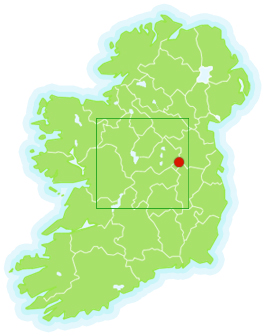
Restoring Raised Bog in Ireland
Coillte, Dublin Road, Newtownmountkennedy, Co. Wicklow | Tel: 01- 201 1111 | Email: raisedbog@coillte.ie

Project Sites
13 – Mount Hevey Bog, Meath and Westmeath, Ireland
SAC No. 2332 / 1584 Total area of the SAC = 537 ha, Project site area = 58.2 ha
Other protection status :
The site is also a proposed Natural Heritage Area – Mount Hevey Bog (Site Code 1584).
Scientific description of site pre-restoration:
 Mount Hevey is a large midland raised bog site which straddles the border between counties Meath and Westmeath. The site is rather long and narrow and most of the intact habitat area lies within two large lobes to the south of a railway line. The site occupies a total area of 537 hectares, 200 hectares of which comprises intact high bog surface. Much of the remaining site area is dominated by cutover bog and recently afforested cutover bog. The high bog surface contains a well-developed flora which includes a range of typical bog species including ling (Calluna vulgaris), bog asphodel (Narthecium ossifragum), bog rosemary (Andromeda polifolia), single-flowered bog cotton (Eriophorum vaginatum), deergrass (Trichophorum cespitosum), cross-leaved heath (Erica tetralix) and various mosses such as Hypnum cupressiforme, Sphagnum capillifolium and S papillosum. Wet pool areas dominated by the moss Sphagnum cuspidatum, bog bean (Menyanthes trifoliata) and white-beaked sedge (Rhynchospora alba) are frequent especially in the wetter, more centrally located, parts of the high bog surface.
Mount Hevey is a large midland raised bog site which straddles the border between counties Meath and Westmeath. The site is rather long and narrow and most of the intact habitat area lies within two large lobes to the south of a railway line. The site occupies a total area of 537 hectares, 200 hectares of which comprises intact high bog surface. Much of the remaining site area is dominated by cutover bog and recently afforested cutover bog. The high bog surface contains a well-developed flora which includes a range of typical bog species including ling (Calluna vulgaris), bog asphodel (Narthecium ossifragum), bog rosemary (Andromeda polifolia), single-flowered bog cotton (Eriophorum vaginatum), deergrass (Trichophorum cespitosum), cross-leaved heath (Erica tetralix) and various mosses such as Hypnum cupressiforme, Sphagnum capillifolium and S papillosum. Wet pool areas dominated by the moss Sphagnum cuspidatum, bog bean (Menyanthes trifoliata) and white-beaked sedge (Rhynchospora alba) are frequent especially in the wetter, more centrally located, parts of the high bog surface.
A large proportion of the high bog margins within this site have been planted with conifers over the past 40 years and this planting has taken place on both intact high bog surface and cutover.
Planting has been especially widespread at the eastern end of this site and the primary aim of this proposal is to remove most of the conifers in this area and to re-create conditions suitable for the regeneration of bog. An area of recent planting adjacent to wet bog has failed and a well-developed intact raised bog flora dominated by ling still occurs (Conaghan and Heery, 2003).
Importance of the site for the conservation of the species/habitat types targeted at regional, national and EU level (give quantifiable information wherever possible):
Mount Hevey Bog is a good example of a midland raised bog site which supports examples of the Annex 1 habitats *active raised bog, degraded raised bog (capable of regeneration) and vegetation of depressions (Rhynchosporion). The habitat assessment presented in the Natura 2000 form compiled for the site gives a global rating of A (excellent value) for active raised bog habitat. Raised bog habitats are now very rare in Europe and it has recently been estimated that the Republic of Ireland contains 50% of the relatively intact oceanic raised bog systems in Europe (O’ Connell, 1998)..
This site contains one of the largest areas of relatively intact raised bog in the eastern half of the country and, in addition, is one of the most easterly remaining extant sites. The raised bogs of counties Meath and Westmeath have been severely impacted by development over the past centuries and at present only a handful of good sites remain in a semi-natural state (Cross, 1990). Despite the damage which has occurred along the margins of this site, primarily as a result of peat extraction and afforestation, there is still a large area of very wet, active raised bog present.
Click here to view PDF Map of the Project site (Coloured yellow) within the SAC (Hatched in Pink)
Click here to view PDF of the Project Site Restoration Report

